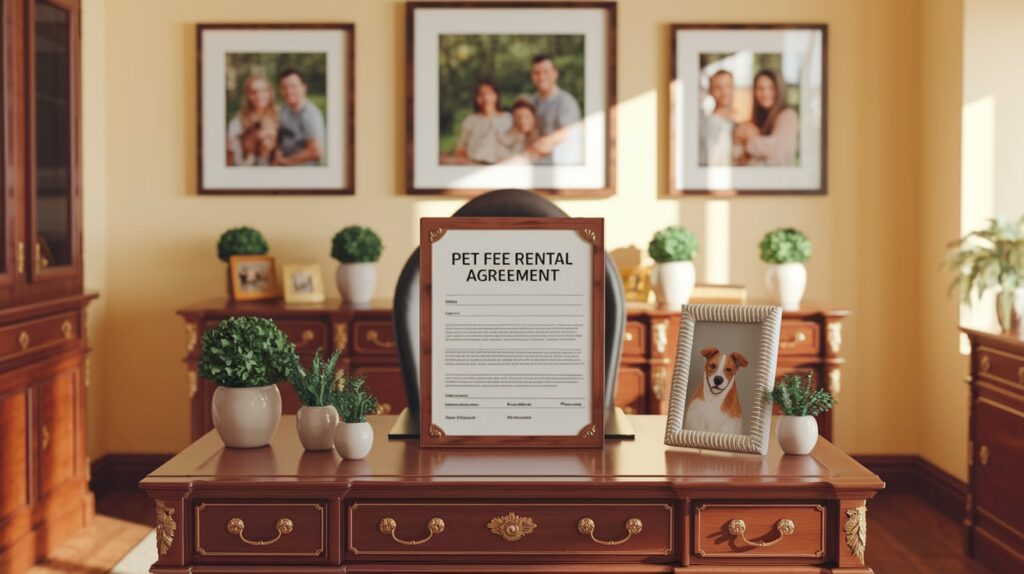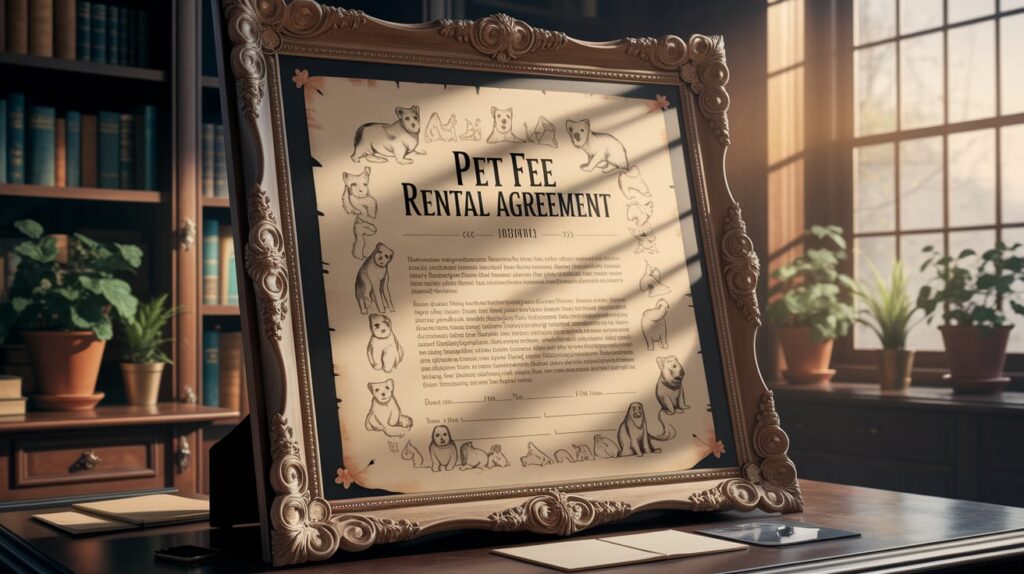Renting with pets involves a pet fee rental agreement. This agreement outlines terms for tenants with pets, ensuring clarity.
Welcoming a pet into your rented home is exciting. Yet, it comes with responsibilities and rules. A pet fee rental agreement plays a crucial role here. It sets the stage for a harmonious living experience between landlords and pet owners.
This agreement details the expectations, fees, and conditions related to having pets in rental properties. It aims to protect both parties and promote a pet-friendly environment. Knowing the ins and outs of such agreements can save you from misunderstandings. It ensures you and your furry friend can enjoy your living space without hassle. Understanding this agreement is key to avoiding surprises and maintaining a positive landlord-tenant relationship.
Introduction To Pet Fee Rental Agreements
Pets bring joy to many homes. Yet, renting with pets can be tricky. This is where pet fee rental agreements come in. These agreements set clear rules for pet owners and landlords. They ensure everyone knows their rights and responsibilities.
Importance Of Clear Terms
Clear terms prevent misunderstandings. Both parties need to know what to expect. The agreement should state the pet fee amount. It should also outline what the fee covers. This can include cleaning costs or potential damage repairs. Clear terms help avoid conflicts later.
Benefits For Landlords And Tenants
Such agreements benefit both landlords and tenants. For landlords, they offer protection. They cover costs for any pet-related damages. This reduces financial risks. Tenants benefit from knowing the rules. It gives them peace of mind. They know what is expected of them.
Agreements create a win-win situation. Landlords can welcome pet owners. Tenants can enjoy their pets without worry. Everyone knows their roles. This leads to a harmonious renting experience.
Key Components Of A Pet Fee Agreement
Pet fee agreements help landlords and tenants manage expectations. These agreements outline the terms for pets in rental properties. Understanding key components ensures a smooth rental experience. This section breaks down essential parts of a pet fee agreement.
Defining Pet Fees
Pet fees are non-refundable charges for pets in a rental. They cover potential wear and tear caused by pets. This fee is separate from a security deposit. Landlords use it to maintain property quality. Clearly define the purpose of the pet fee in the agreement. Specify what the fee covers and what it does not.
Setting Fee Amounts
Setting a fair pet fee is crucial. It should reflect potential damage pets might cause. Research local standards to determine appropriate amounts. Consider the type and size of the pet. Larger pets may require higher fees. Ensure the fee is reasonable and justifiable. Both parties should agree on the amount before signing the agreement.
Legal Considerations
Pet fee rental agreements need careful legal considerations. Understanding the laws ensures compliance and smooth interactions. Ignoring them can lead to disputes or fines. It’s crucial to know local regulations and fair housing laws.
Local Regulations
Local regulations vary across regions. Landlords must check specific city or state rules. Some areas have strict pet policies. Others might have lenient rules. Not following these can result in penalties. Always research local laws before drafting agreements.
Fair Housing Laws
Fair housing laws protect tenant rights. They also cover pet-related agreements. Discrimination based on pets, like service animals, is illegal. Ensure your pet fees comply with these laws. Violating them can lead to serious consequences. Know these laws to avoid issues.
Customizing Your Agreement
Customizing your pet fee rental agreement can make life easier for both landlords and tenants. It’s not just about adding a fee; it’s about crafting a document that respects your property while ensuring tenants feel welcome with their furry friends. A personalized agreement can help avoid misunderstandings and create a harmonious relationship between you and your tenant. Dive into these essential aspects to tailor your pet policy effectively.
Pet Types And Sizes
Not all pets are created equal. Consider the types and sizes of pets that tenants might have. Is your property suitable for large dogs, or is it better suited for small animals? Think about space, noise, and potential damage. You might allow cats and small dogs but draw the line at larger breeds. This ensures your property remains in good shape while accommodating tenants’ preferences.
Consider sharing a personal story about a tenant whose Great Dane enjoyed your spacious backyard. Large pets can be a joy, but they need appropriate space. Would you prefer a tenant with a small poodle that fits comfortably in a one-bedroom apartment? Decide what works best for your property.
Multiple Pets Policies
What happens when a tenant has more than one pet? Some renters might have a couple of cats or a dog and a cat. Multiple pets can mean more wear and tear. Consider setting limits on the number of pets allowed. This keeps your property in better condition and ensures tenants don’t overcrowd their living spaces.
Think about how multiple pets might affect noise levels and cleanliness. Have you ever had a tenant with three pets, all perfectly behaved? Setting clear guidelines helps manage expectations and maintain peace. Would allowing more than two pets lead to potential issues? Customize your policy to balance tenant happiness and property maintenance.
Creating a pet-friendly rental agreement isn’t just about adding a fee. It’s about understanding the nuances of pet ownership and how it impacts your property. Think about your property’s size and suitability, the types of pets, and how many you’re comfortable with. This approach ensures you protect your investment while offering tenants a warm welcome for their beloved pets.
Communicating With Tenants
Discussing pet fee rental agreements with tenants requires clear communication. These agreements outline costs and responsibilities for pet-friendly rentals. Clear terms help prevent misunderstandings, ensuring a smooth renting experience for both landlords and tenants.
Communicating effectively with tenants about pet fee rental agreements is key to maintaining a harmonious landlord-tenant relationship. It’s essential to ensure that all parties understand the terms and the reasoning behind them. This can prevent misunderstandings and foster a sense of trust and transparency between you and your tenants. Let’s dive into how you can achieve this.
Transparent Terms
Clarity is crucial when discussing pet fees. Clearly outline what the pet fee covers and why it’s necessary. This might include additional cleaning, potential damage repairs, or even insurance costs.
Provide this information in writing, perhaps as part of the lease agreement or as a separate document. This ensures that tenants have something to refer back to if they have questions later.
Have you ever faced confusion over terms in a past agreement? Use that experience to improve clarity here. By preempting questions and providing detailed explanations, you can minimize future disputes.
Addressing Concerns
Listen actively to your tenants’ concerns. They may worry about the cost or question the fairness of the fee. Acknowledge these concerns and explain the rationale behind the charges.
Offer examples of situations where the pet fee has been beneficial. For instance, mention how it helped cover costs for pet-related damages in the past.
Are you open to negotiating terms? Let tenants know. Flexibility can often resolve issues amicably. You might consider offering a pet deposit instead of a non-refundable fee to ease their concerns.
Effective communication involves a balance of clarity, empathy, and openness. By addressing tenants’ questions and concerns with patience, you build stronger, more positive relationships.
Enforcing Pet Policies
A pet fee rental agreement outlines costs for pet-related wear and tear in rental properties. It helps landlords manage damages. Tenants understand their responsibilities, ensuring harmonious living with pets.
Enforcing pet policies in a rental agreement is crucial to maintaining a harmonious living environment for all tenants. With more pet-friendly rentals available, ensuring that pet policies are adhered to can prevent issues and keep everyone happy. Here’s how you can enforce these policies effectively.
Routine Inspections
Routine inspections are essential to ensure tenants are following pet policies. Schedule regular visits to check for any signs of damage or unauthorized pets.
Announce these inspections in advance. This gives tenants time to prepare and shows respect for their privacy.
Look for signs of pet-related damage, such as scratched floors, chewed furniture, or lingering odors. Document any findings with photos and notes.
Handling Violations
When tenants violate pet policies, address the issue promptly. A clear and consistent approach is key.
Start with a friendly reminder. Sometimes, a simple conversation can resolve the issue. Explain the violation and the necessary steps to correct it.
If the problem persists, issue a written warning. Outline the specific violation and the consequences of continued non-compliance.
For serious or repeated violations, consider imposing fines or, as a last resort, terminating the lease. Ensure all actions align with local laws and the terms of the rental agreement.
Have you ever had to enforce pet policies in your rental property? What strategies worked best for you? Share your thoughts in the comments below.
Handling Pet-related Damages
A Pet Fee Rental Agreement can help manage pet-related damages. It sets clear expectations and covers repair costs. Protects both tenants and landlords.
Having pets in your rental property can bring joy, but it also comes with potential risks. Pet-related damages are a common concern among landlords. How do you handle these situations fairly? Here’s a practical guide to help you navigate through the process.
Damage Assessments
Assessing damage caused by pets requires a keen eye. Start by taking detailed photos before move-in. This helps in comparing the state of the property before and after the tenancy.
Regular inspections are crucial. They allow you to spot issues early, preventing minor damage from becoming major. Keep a checklist handy to make sure you don’t miss anything.
Consider using professional assessment services if the damage is extensive. They can provide an unbiased evaluation, ensuring a fair resolution.
Deduction Procedures
When it comes to deductions, clarity is key. Clearly outline in the rental agreement what constitutes pet-related damage and the associated costs. This avoids confusion and disputes later on.
Communicate with your tenant about the damages and costs involved. Transparency fosters trust and cooperation. Provide evidence, like photos and inspection reports, to support your claims.
Deposit deductions should be itemized. List each damage and its corresponding cost. This makes it easier for tenants to understand and accept the deductions.
Handling pet-related damages doesn’t have to be stressful. With clear guidelines and effective communication, you can manage it smoothly. Have you ever faced a tricky situation with pet damages? How did you handle it? Share your thoughts in the comments below!
Calculator: Pet Fee for Rental Agreement
This Pet Fee for Rental Agreement Calculator allows users to input details such as the monthly rent, pet fee percentage (or fixed amount), and additional pet-related costs (e.g., deposits or monthly pet rent). It then calculates the total cost associated with having a pet in a rental property.
Pet Fee Rental Agreement Calculator
Tips For Tenant Compliance
Creating a pet fee rental agreement can ensure harmony between landlords and tenants. Clear guidelines help tenants comply with the agreement. This not only safeguards property but also promotes responsible pet ownership. Encouraging tenants to adhere to terms strengthens the landlord-tenant relationship. Below are some practical tips for tenant compliance.
Encouraging Responsibility
Responsibility starts with understanding the agreement. Explain the importance of caring for pets. Educate tenants on keeping pets clean and healthy. Pet behavior impacts the property condition. Encourage tenants to regularly check for damage. This helps in maintaining a clean environment. Highlight the consequences of neglect. This ensures tenants take the agreement seriously.
Providing Resources
Offer resources to assist tenants. Provide contacts for local veterinarians. Share information on pet training classes. Suggest nearby parks for exercise. Supply details on pet-friendly facilities. These resources help tenants care for their pets. Educate them on pet-related regulations. Providing guidance promotes compliance. Tenants appreciate helpful advice.

Examples Of Pet Fee Agreements
A pet fee rental agreement outlines the fees and rules for having pets in a rental property. Examples include one-time pet deposits, monthly pet fees, and specific pet-related rules. These agreements help ensure a clear understanding between landlords and tenants.
When considering renting your property to pet owners, it’s crucial to have a clear understanding of pet fee agreements. These agreements not only protect your property but also clarify expectations for both parties involved. By examining examples of pet fee agreements, you can better understand what clauses to include and how they apply in real-world scenarios.
Sample Clauses
A well-crafted pet fee agreement starts with clear clauses. One common clause is the non-refundable pet fee. This fee covers potential wear and tear caused by pets.
Another clause often included is detailing the number of pets allowed. Imagine the surprise of discovering a tenant with four dogs when you only agreed to one!
Consider a clause specifying pet-related damages. This gives you authority to charge for any repair costs beyond normal wear.
Real-world Scenarios
Imagine you rent out your apartment to a young couple with a cat. You included a pet fee agreement with a clause about noise disturbances.
A month later, they adopt a parrot that disrupts neighbors with constant squawking. How do you handle this situation? Your well-defined agreement should offer guidance.
Or picture renting to a family with a dog. They assure you the dog is house-trained, but the carpet says otherwise. In this scenario, the damage clause in your agreement becomes vital.
These situations highlight the importance of specific clauses and how they can make or break your rental experience. Are you prepared for such occurrences?
By examining these examples and scenarios, you equip yourself with insights to draft effective pet fee agreements. You can maintain peace of mind knowing your property is protected.
What unique clauses might you consider adding to your agreement?
Frequently Asked Questions
Are Pet Fees Legal In Texas?
Yes, pet fees are legal in Texas. Landlords can charge pet deposits or fees for potential damages. Always review your lease agreement for specific terms regarding pet policies. Ensure you understand the difference between refundable deposits and non-refundable fees before signing.
Do Pet Fees Count As Rental Income?
Yes, pet fees count as rental income. They are considered additional charges by landlords for allowing pets.
How To Negotiate Pet Fee?
Research average pet fees in your area first. Highlight your pet’s good behavior and cleanliness. Offer to pay a refundable deposit instead. Suggest a trial period to demonstrate responsibility. Be polite and flexible during negotiations to reach an agreement.
Why Do People Charge A Pet Fee?
People charge a pet fee to cover potential damages, cleaning costs, and maintenance caused by pets. This fee helps ensure the property remains in good condition, covering extra wear and tear pets may cause. It also compensates for any additional amenities or services provided for pets.
Conclusion
A pet fee rental agreement protects both landlords and tenants. It sets clear rules for pet ownership in rented homes. Tenants know their responsibilities. Landlords prevent property damage. This agreement promotes trust and harmony. Pets enjoy a safe environment. Owners have peace of mind.
Clear terms prevent misunderstandings. Both parties benefit from transparency. A well-crafted agreement helps avoid conflicts. It ensures a smooth rental experience. Pet owners should always read terms carefully. Signing means agreeing to all conditions. A thoughtful agreement leads to happy, stress-free renting for everyone involved.
Reference Data and Sources:
- Americans with Disabilities Act (ADA) and Fair Housing Act (FHA)
- State and Local Laws: Texas Property Code 92.006 & California Civil Code § 1950.5
Disclaimer: The content on this page is for general information only and should not be considered legal advice. We work hard to provide accurate and up-to-date details, but we can't guarantee the completeness or accuracy of the information. Laws and rules change often, and interpretations may vary. For specific advice, always consult a qualified legal expert. We are not liable for any actions you take based on this information. If you spot any errors or outdated content, please contact us, and we’ll update it as soon as possible.


